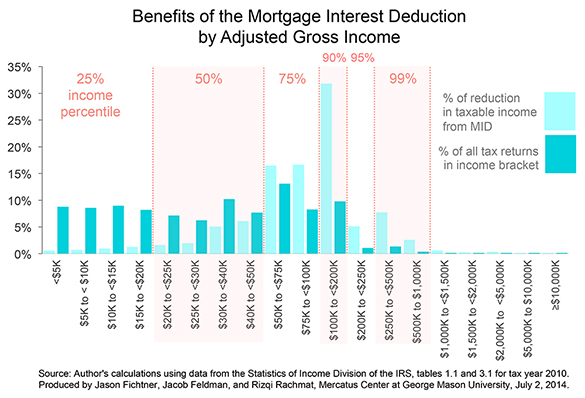- | Academic & Student Programs Academic & Student Programs
- | Government Spending Government Spending
- | Data Visualizations Data Visualizations
- |
Low-Income Taxpayers Benefit Least from Mortgage Deduction
One of the most commonly cited justifications for the mortgage interest deduction (MID) is the claim that the deduction promotes homeownership among the middle class and supports industries that employ middle-class workers. But with 65.2 percent of all tax filers claiming to make less than $50,000, only 9.8 percent of these returns used the mortgage interest deduction.
One of the most commonly cited justifications for the mortgage interest deduction (MID) is the claim that the deduction promotes homeownership among the middle class and supports industries that employ middle-class workers.1 But with 65.2 percent of all tax filers claiming to make less than $50,000, only 9.8 percent of these returns used the mortgage interest deduction. By an economic valuation, the MID is a sizable tax subsidy—one of the largest tax deductions in the code (behind the exclusion of employer contributions for medical insurance premiums and the exclusion of all pension and retirement contributions), which decreased federal revenues by an estimated $69 billion in 2013. While the upper middle class does benefit from the deduction, the vast majority of the dollar benefits go to higher-income taxpayers while little to no dollar benefits go to low-income households that purchase homes.
One reason that low-income and many middle-income taxpayers are unlikely to use the MID is that the standard deduction for an individual taxpayer in 2014 is $6,200 ($12,400 if married and filing a joint tax return). Unless annual mortgage interest expenses (combined with any other expenses that are allowed as itemized tax deductions) are greater than the standard deduction, a taxpayer will not opt to itemize deductions. Instead, the individual will take the simpler and more financially sound route of using the standard deduction.2
The purported public policy role of housing-related tax deductions and credits is to increase homeownership. As currently structured, the MID fails to significantly increase homeownership among its intended beneficiaries, and it encourages greater debt among homeowners.3 In short, the MID is generally giving a tax break to households that would likely purchase homes anyway and enabling high-income households to buy homes that are roughly 10–20 percent larger than those they would buy otherwise.4
Economic inefficiencies will only be eliminated with a full repeal of tax-favorable housing policies in exchange for lower marginal rates, but if tax-favored housing must exist, it should at a minimum promote homeownership among low-income and middle-income households.
1 Rick Judson, “Keep Homeowners’ Tax Deduction: Opposing View,” USAToday, April 2, 2013, http://www.usatoday.com/story/opinion/2013/04/02/mortgage-tax-deduction….
2 The standard deduction serves two important roles: to simplify the tax code and to favor lower-income taxpayers by making the tax code more progressive. Part of the design of the standard deduction is rendering it unnecessary for some taxpayers to track their tax-related expenditures throughout the year, since that cumulative effort wouldn’t exceed the standard deduction. For millions of taxpayers, simply taking the standard deduction saves time and resources. However, the standard deduction is also designed to reduce the taxable income of low-income taxpayers, regardless of whether any tax-related expenditures have been incurred. (Along these lines, tax-related expenditures might be viewed as having gone to waste. In short, in a world where there must be tax-favored spending, it seems that increasing the number of low- and middle-income housing units would reap more social benefits than an equal amount of money in subsidies given to high-income earners.)
3 David C. Ling and Gary A. McGill, “Evidence on the Demand for Mortgage Debt by Owner-Occupants,” Journal of Urban Economics 44, no. 3 (1998): 391–414; James R. Follain and Lisa Sturman Melamed, “The False Messiah of Tax Policy: What Elimination of the Home Mortgage Interest Deduction Promises and a Careful Look at What It Delivers,” Journal of Housing Research 9, no. 2 (March 2000): 179–99.
4 John E. Anderson, Jeffrey Clemens, and Andrew Hanson, “Capping the Mortgage Interest Deduction,” National Tax Journal 60, no. 4 (December 2007): 769–85; Harvey S. Rosen, “Housing Decisions and the U.S. Income Tax: An Econometric Analysis,” Journal of Public Economics 11, no. 1 (February 1979): 1–23.
To speak with a scholar or learn more on this topic, visit our contact page.


